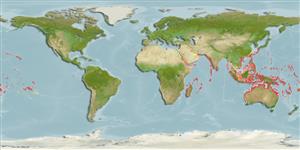>
Acanthuriformes (Surgeonfishes) >
Acanthuridae (Surgeonfishes, tangs, unicornfishes) > Acanthurinae
Etymology: Acanthurus: Greek, akantha = thorn + Greek, oura = tail (Ref. 45335).
More on author: Forsskål.
Environment: milieu / climate zone / distribuzione batimetrica / distribution range
Ecologia
marino associati a barriera corallina; non migratori (Ref. 56001); distribuzione batimetrica 0 - 25 m (Ref. 48637), usually 2 - 25 m (Ref. 27115). Tropical; 24°C - 28°C (Ref. 27115); 31°N - 34°S, 3°E - 123°W
Indo-Pacific: Red Sea south to Transkei, South Africa (Ref. 3145) and east to the Hawaiian and Tuamoto islands, north to southern Japan, south to the southern Great Barrier Reef, New Caledonia, and Rapa (Austral Islands).
Length at first maturity / Size / Peso / Age
Maturità: Lm 12.0, range 10 - 14 cm
Max length : 21.0 cm TL maschio/sesso non determinato; (Ref. 30573)
Spine dorsali (totale) : 9; Raggi dorsali molli (totale) : 24 - 27; Spine anali: 3; Raggi anali molli: 22 - 24. Brown in color when preserved; with or without fine bluish gray longitudinal lines on body; pale pectoral fins with upper edge narrowly black; pelvic fins brown. Lips blackish brown; median upper teeth tend to be pointed. Dorsal fin base with a prominent black spot larger than 1/2 eye diameter; a smaller spot on base of anal fin. Groove of caudal spine encircled with a narrow black margin. Gill rakers on anterior row:20-24; on posterior row:18-23.
Body shape (shape guide): short and / or deep; Cross section: compressed.
Found on hard substrates of shallow lagoon and seaward reefs from the lower surge zone to a depth of more than 15 m (Ref. 27825). Benthopelagic (Ref. 58302). Feed on filamentous algae. Form spawning aggregations (Ref. 27825, 48637). Adults usually in small groups, but form large schools in some oceanic locations. Juveniles are often seen in mixed species aggregations (Ref. 48637). Species at the bottom of the 'pecking order' among surgeon fishes, and as a result employs the strategy of feeding in large schools that overwhelm the territorial defenses of other herbivores (Ref. 1602). Caught with nets (Ref. 30573). Can be eaten both raw and cooked (Ref. 7364). Maximum depth reported at 25m (Ref. 027115)
Life cycle and mating behavior
Maturità | Riproduzione | Deposizione | Uova | Fecundity | Larve
Form spawning aggregations (Ref. 27825).
Randall, J.E., 1956. A revision of the surgeonfish genus Acanthurus. Pac. Sci. 10(2):159-235. (Ref. 1920)
IUCN Red List Status (Ref. 130435: Version 2025-1)
Threat to humans
Reports of ciguatera poisoning (Ref. 31637)
Human uses
Pesca: commerciale; Acquario: Commerciale
Strumenti
Special reports
Download XML
Fonti Internet
Estimates based on models
Preferred temperature (Fonte Biblio.
123201): 24.6 - 29, mean 27.7 °C (based on 938 cells).
Phylogenetic diversity index (Fonte Biblio.
82804): PD
50 = 0.5000 [Uniqueness, from 0.5 = low to 2.0 = high].
Bayesian length-weight: a=0.02512 (0.02076 - 0.03039), b=2.96 (2.92 - 3.00), in cm total length, based on LWR estimates for this species (Ref.
93245).
Trophic level (Fonte Biblio.
69278): 2.0 ±0.0 se; based on diet studies.
Resilienza (Fonte Biblio.
120179): Medio, tempo minimo di raddoppiamento della popolazione 1.4 - 4.4 anni (K=1.00-1.72; tm=2).
Fishing Vulnerability (Ref.
59153): Low to moderate vulnerability (27 of 100).
🛈
Nutrients (Ref.
124155): Calcium = 84.4 [37.2, 254.5] mg/100g; Iron = 0.908 [0.345, 2.248] mg/100g; Protein = 18.1 [16.9, 19.3] %; Omega3 = 0.105 [0.048, 0.228] g/100g; Selenium = 16.6 [5.8, 50.9] μg/100g; VitaminA = 42 [10, 168] μg/100g; Zinc = 3.34 [1.04, 6.25] mg/100g (wet weight);
